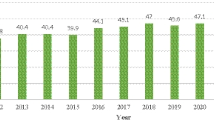Abstract
Information on expenditure and income are the most widely used tolls for differentiating economic status of households. In many surveys it’s hard to compile data on expenditure and income. In such cases questioning the availability of household amenities would serve as a tool for constructing an asset index and thus differentiating economic status of households. This study is conducted to see the extent of compatibility of an asset index with expenditure and income which serve as a tool for differentiating economic status of households. The data source used in the study is the 2012 Turkish Statistical Institute Household Budget Survey. This survey has the property to be the only survey which encompasses all the three variables in Turkey. An asset index was constructed by using Principal Components Analysis and comparisons were made among the indicators. This study showed that asset index quite well overlaps expenditure and income quintiles at the lowest and highest quintiles. More than 60 % of those in the lowest expenditure quintile are also in the lowest asset index quintile. Overlapping is much less for the quintiles in between. The results don’t indicate whether asset index or other indicators are differentiating economic status of households better. In either case asset index can be considered to be an efficient tool for differentiating the lowest quintile. Pearson’s correlation coefficient analyses were conducted among the indicators. The coefficient is 0.75 between expenditure and income quintiles. It is 0.64 between asset index and expenditure quintiles and 0.63 between asset index and income quintiles. These values imply that the relationship between asset index, expenditure and income quintiles can be regarded to be quite high.
Similar content being viewed by others
References
Azzarri, C., et al. (2006). Monitoring poverty without consumption data—An application using the Albania Panel Survey. Eastern European Economics, 44(1), 59–82.
Ferguson, B., et al. (2002). Estimating permanent income using indicator variables, evidence and information for policy cluster. Geneva, Switzerland: World Health Organization.
Filmer, D., & Pritchett, L. H. (2001). Estimating wealth effects without expenditure data—or tears: an application to educational enrollments in states of India. Demography, 38, 115–132.
Foreit, K. G. F, & Schreiner, M. (2011). Comparing alternative measures of poverty: Assets-based wealth index vs. expenditures-based poverty score. Measure evaluation PRH working paper No. 11–113.
Howe, L. D. (2009). The wealth index as a measure of socioeconomic position. PhD thesis, London School of Hygiene Tropical Medicine.
HUIPS (Hacettepe University Institute of Population Studies). (2009). Turkey Demographic and Health Survey, 2008. Ankara, Turkey: Hacettepe University Institute of Population Studies, Ministry of Health General Directorate of Mother and Child Health and Family Planning, T.R. Prime Ministry Undersecretary of State Planning Organization and TUBITAK.
Lindelow, M. (2006). Sometimes more equal than others: How health inequalities depend on the choice of welfare indicator. Health Economics, 15(3), 263–279.
McKenzie, D. J. (2005). Measuring inequality with asset indicators. Journal of Population Economics, 18(2), 229–260.
Øvensen, G. (2006). An asset index for the 2003 Syrian unemployment survey. Fafo-paper. http://www.fafo.no/pub/rapp/792/792.pdf.
Rutstein, S. O., & Johnson, K., (2004). The DHS Wealth Index. DHS Comparative Reports No. 6. ORC Macro, Calverton, MD.
Sahn, D. E., & Stifel, D. (2000). Poverty comparisons over time and across countries in Africa. World Development, 28(12), 2123–2155.
Sahn, D. E., & Stifel, D. (2003). Exploring alternative measures of welfare in the absence of expenditure data. Review of Income and Wealth, 49(4), 463–489.
Skoufias, E., & Coady, D. P. (2007). Are the welfare losses from imperfect targeting important? Economica, 74(296), 756–776.
Sumarto, S., Suryadarma, D., & Suryahadi, A. (2007). Predicting consumption poverty using non-consumption indicators: Experiments using Indonesian data. Social Indicators Research, 81(3), 543–578.
Wagstaff, A., & Watanabe, N. (2003). What difference does the choice of SES make in health inequality measurement? Health Economics, 12(10), 885–890.
Ward, P., Owens, T., & Kahyrara, G. (2002). Developing proxy predictors for household expenditure and income poverty. Oxford Policy Management.
Author information
Authors and Affiliations
Corresponding author
Additional information
Calculations and evaluations belong to the author. Turkish Statistical Institute is not responsible for the author’s comments.
Rights and permissions
About this article
Cite this article
Ucar, B. The Usability of Asset Index as an Indicator of Household Economic Status in Turkey: Comparison with Expenditure and Income Data. Soc Indic Res 121, 745–760 (2015). https://doi.org/10.1007/s11205-014-0670-2
Accepted:
Published:
Issue Date:
DOI: https://doi.org/10.1007/s11205-014-0670-2




